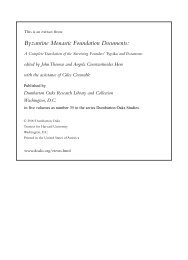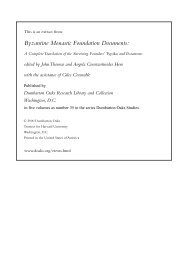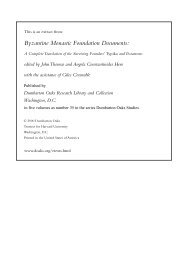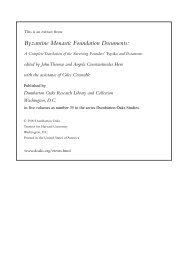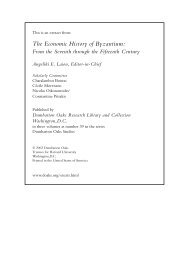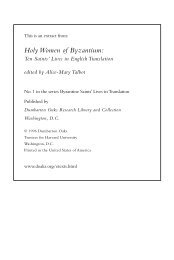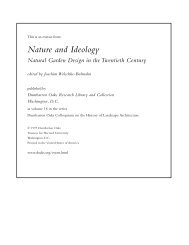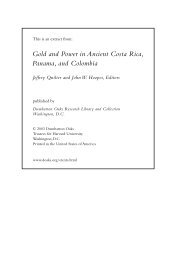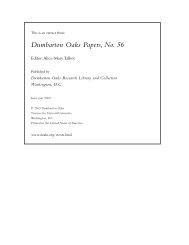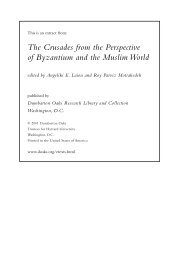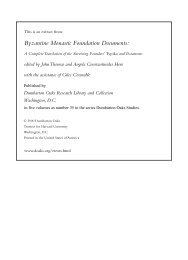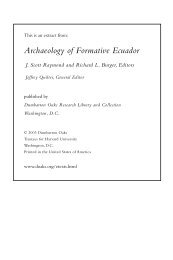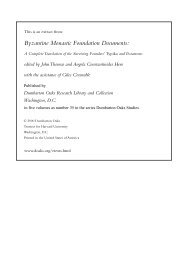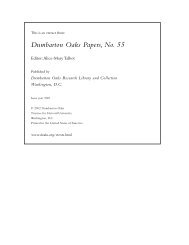7. Life of St. Theodora of Thessalonike - Dumbarton Oaks
7. Life of St. Theodora of Thessalonike - Dumbarton Oaks
7. Life of St. Theodora of Thessalonike - Dumbarton Oaks
You also want an ePaper? Increase the reach of your titles
YUMPU automatically turns print PDFs into web optimized ePapers that Google loves.
<strong>St</strong>. <strong>Theodora</strong> <strong>of</strong> <strong>Thessalonike</strong> 175<br />
selves on the revelations from above <strong>of</strong> the Holy Scriptures and on the apostolic<br />
and patristic traditions, we render the reverence <strong>of</strong> veneration in a fitting and<br />
relative manner in honor <strong>of</strong> the person depicted. 71 Thus when we consecrate the<br />
icon <strong>of</strong> Christ with reverence and veneration, we do not circumscribe the reverence<br />
and honor in it [i.e., the icon], but we direct and <strong>of</strong>fer these <br />
to the One Who became incarnate for our sake through the ineffable wealth <strong>of</strong><br />
His love for mankind. 72 Thus we venerate the thrice-blessed and life-giving<br />
wood <strong>of</strong> the cross, on which the body <strong>of</strong> the Lord was stretched, and the blood<br />
that cleanses all filth, that purifies all the world, poured forth from His side<br />
that flows with life; and watered by its streams, it [the cross] changed its nature<br />
and produced eternal life for us instead <strong>of</strong> death. Thus we venerate the symbol<br />
<strong>of</strong> the cross, by which phalanxes <strong>of</strong> demons are put to flight and incurable diseases<br />
are healed, as if the same grace and power in the prototype<br />
were operative in the symbolic form. 73 Thus when we render the reverence <strong>of</strong><br />
veneration to the other holy symbols and holy places <strong>of</strong> our pure and holy worship,<br />
74 we are not divided into various and different rites, but through their visible<br />
different and divisible worship and veneration we are led indivisibly to that indivisible,<br />
uniform and unifying divinity. 75 Thus we honor and venerate the holy icons<br />
<strong>of</strong> our all-pure Lady the Mother <strong>of</strong> God and <strong>of</strong> all the saints in proportion to 76<br />
the pre-eminence and venerability <strong>of</strong> their prototypes, 77 and [p. 94], to sum up,<br />
we venerate in a relative manner the relics and churches and tombs <strong>of</strong> the saints,<br />
and other things <strong>of</strong> this sort, in our unblemished and holy rites. For we acknowledge<br />
and praise the original and primordial cause through the gift and blessing<br />
worked by them. 78 And we do not depict in an icon 79 that which cannot be<br />
71 Phot., ep. 1.424–26.<br />
72 Phot., ep. 1.442–4<strong>7.</strong><br />
73 Phot., ep. 1.435–40.<br />
74 Phot., ep. 1.428–29.<br />
75 Phot., ep. 1.431–34.<br />
76 After ajnalogían, Paschalides omitted the phrase th'" tw'n prwtotúpwn uJperoch'"<br />
kaì sebasmióthto", kaì . . . which is to be found in the Arsenij ed., p. 8.38–39 (and in<br />
the letter <strong>of</strong> Photios).<br />
77 Phot., ep. 1.456–58.<br />
78 Phot., ep. 1.447–53.<br />
79 ´<br />
Here eijkw n has the double meaning <strong>of</strong> “icon” and “image.”




